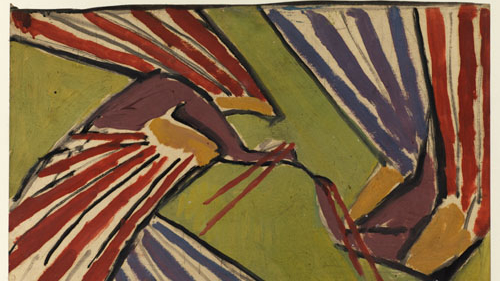
Beyond Bloomsbury: Designs of The Omega Workshops 1913–19
18 June – 20 September 2009
Established in 1913 by the painter and influential art critic Roger Fry, the Omega Workshops were an experimental design collective, whose members included Vanessa Bell, Duncan Grant and other artists of the Bloomsbury Group.
Well ahead of their time, the Omega Workshops brought the experimental language of avant-garde art to domestic design in Edwardian Britain. They were a laboratory of design ideas, creating a range of objects for the home, from rugs and linens to ceramics, furniture and clothing – all boldly coloured with dynamic abstract patterns. No artist was allowed to sign their work, and everything produced by the Workshops bore only the Greek letter Ω (Omega).
The exhibition unites The Courtauld’s uniquely important collection of Omega working drawings with the finest examples of the Workshops’ printed fabrics, Cubist-inspired rugs and splendidly painted textiles, as well as ceramics and furniture to explore the Omega Workshops’ radical approach to modern design.
This exhibition unites the largest collection of surviving working drawings of the Omega Workshops, bequeathed to The Courtauld Gallery by Fry’s daughter Pamela Diamand in 1958, with the finest examples of their printed linens, hand-knotted rugs, woven wools and splendidly painted silks. Concentrating on textiles and designs for textiles, the exhibition explores how the Omega artists moved from a painterly idea to the finished object. At the heart of the exhibition are spectacular examples of the Omega’s range of abstract printed furnishing fabrics, ranging from the geometrical Mechtilde, named after the German ambassador’s wife, to the fluid and painterly Pamela, named after Fry’s daughter. Various colourways are displayed to show how printed textiles attained a freedom of expression comparable to painting on canvas. One of the highlights of the group of large-scale design drawings is a sketch, perhaps for a rug or scarf, which bears comparison with the very boldest abstract paintings of the period.
One of the revelations of the exhibition is the so-called Peacock Stole. This long stole of chiffon silk, which remained unsold, is painted in primary colours with a bold motif of confronting peacocks. Conserved especially for the exhibition, it has not been on view for over fifty years and this is a unique opportunity to see it reunited with two preparatory drawings in The Courtauld’s collection. Shown nearby is Vanessa Bell’s important painted screen Bathers in a Landscape – a transitional object between fine and decorative art, which displays passages of pure decoration and colour that resonate with the abstract textiles.
Another highlight in the exhibition is the set of spectacular rugs designed at the Omega, and probably made at the Royal Wilton Carpet Factory. These are shown together with their working drawings to reveal aspects of the design, commissioning and manufacturing process. The include the striking Ideal Home Exhibition Rug and a small jewel of a rug designed by Vanessa Bell for Lady Ian Hamilton’s flat at 1 Hyde Park Gardens. The finished rugs intentionally preserve the loose informal quality of the original design drawings, which was such an important part of the Omega’s modernist aesthetic.
The exhibition also demonstrates the diversity and range of media made and sold at the Omega Workshops, in particular ceramics. It includes a distinctive selection of the tableware Fry made for the Omega, as well as a few lively, Matisse-inspired painted plates and a row of handheld terracotta cats by the French sculptor Henri Gaudier-Brzeska, each glazed in a different colour, echoing Fry’s experiments in glazes. The displays conclude with examples of other Omega products, illustrating the range of their design activity, including a Ballets Russes-inspired waistcoat made from an Omega woven fabric called Cracow, a marquetry tray by Gaudier-Brzeska, painted furniture and a series of eye-catching Cubist-inspired lamp-stands.
Lead Supporter
The Friends of The Courtauld
Additional support
The Drapers’ Charitable Foundation





